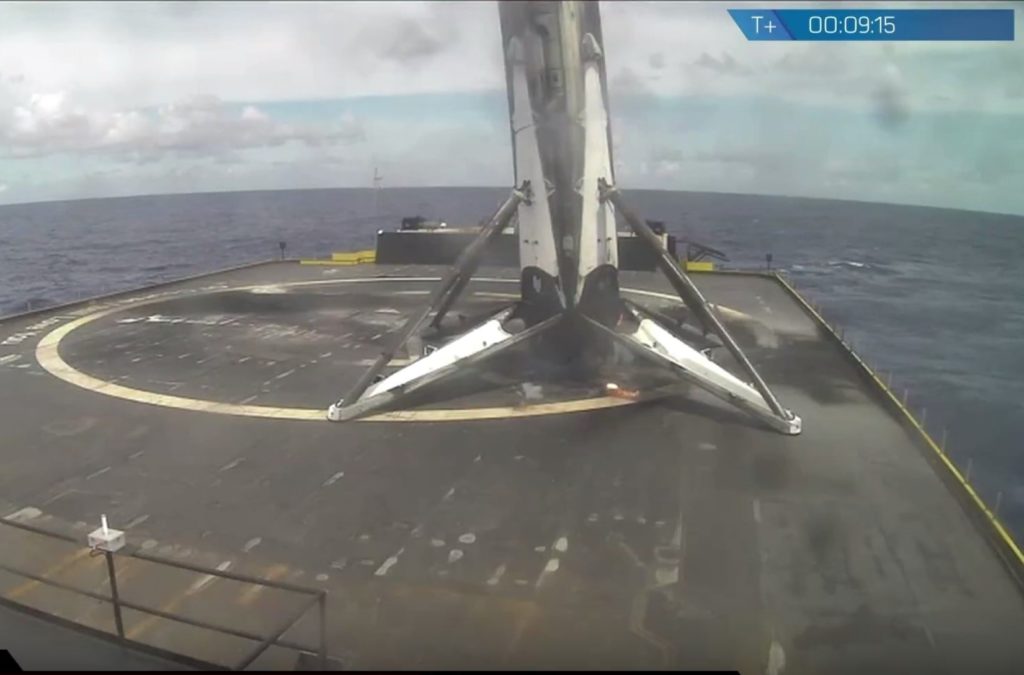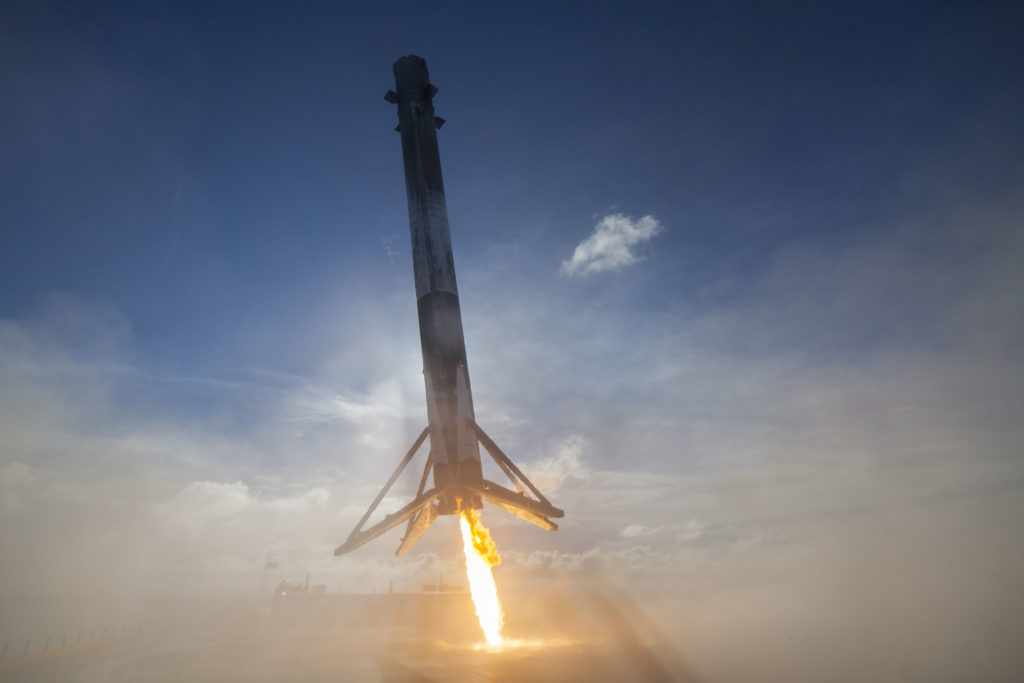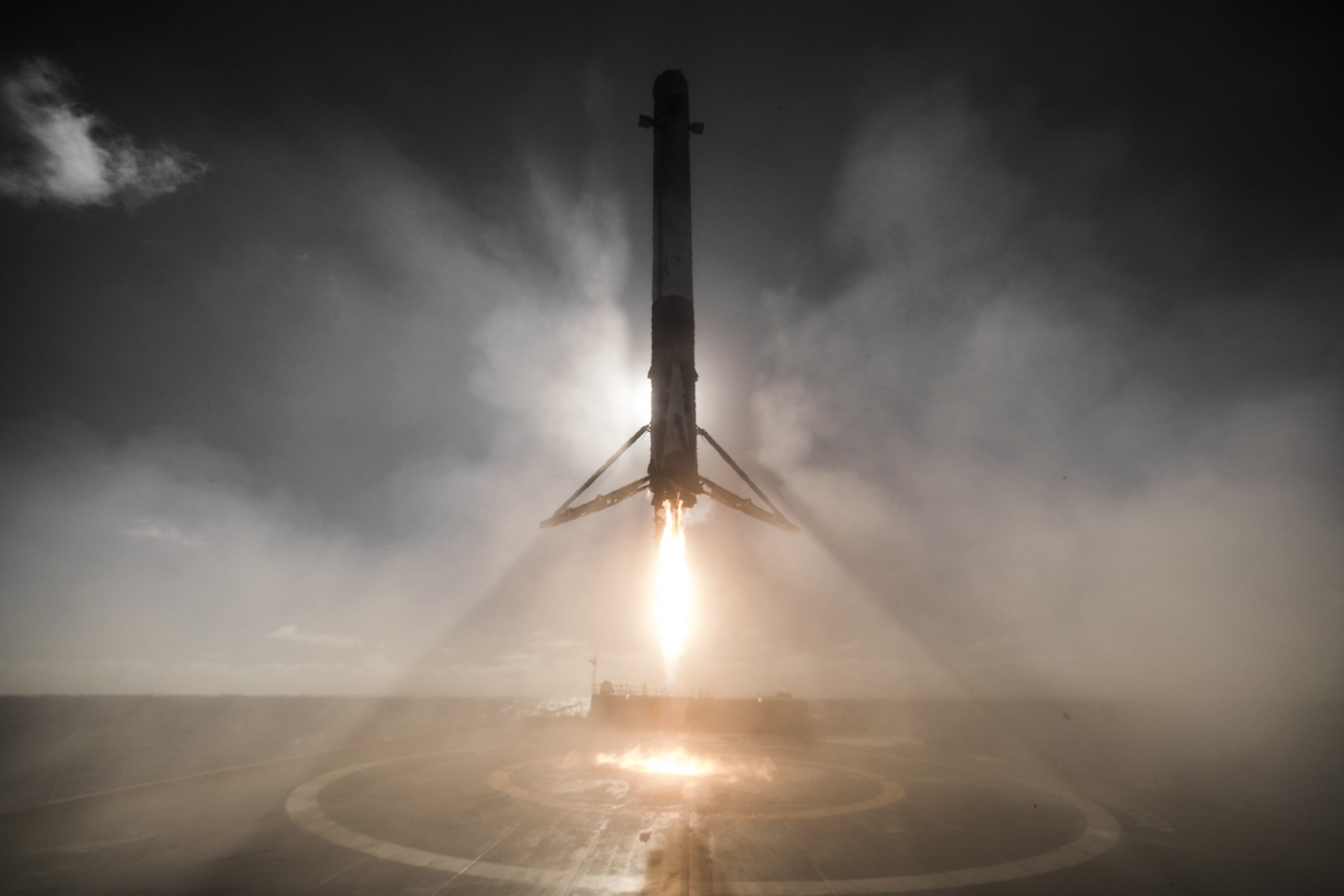
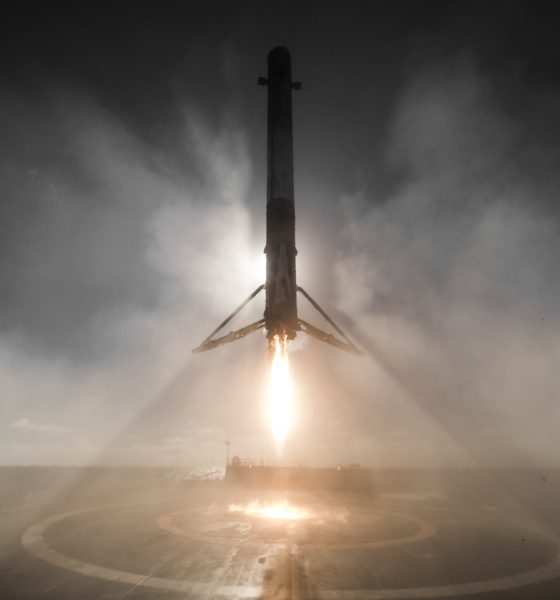
News
SpaceX drone ship returns to Los Angeles Port with recovered Falcon 9
Just over three days after SpaceX successfully launched its Iridium-2 payload and recovered the first stage aboard its Western drone ship, the autonomous spaceport drone ship (ASDS) has returned to port to begin the process of offloading its Falcon 9 passenger.
Locals have already begun to post photos on Twitter, and at least one fan livestreamed the arrival. Higher quality photos will undoubtedly arrive soon, and the docking of a drone ship usually closely precedes SpaceX releasing photos of the first stage recovery.

Just Read the Instructions and Falcon 9 B1036 in all its soot-covered glory. (Periscope/@freddyp75)
This marks the second time that SpaceX has recovered an intact Falcon 9 on the West Coast, with the previous recovery also following an Iridium launch in January 2017. Fans might remember the unsuccessful recovery attempt following the West Coast launch of Jason-3, which gracefully fell over upon landing after one of its legs failed to lock. The octaweb and other parts of that first stage were last seen stored outside near SpaceX’s Hawthorne, California facilities.
This booster will also likely end up at Hawthorne before being sent to McGregor, Texas. However, there is also a chance that it will be transported directly to McGregor or even to the company’s Kennedy Space Center facilities for refurbishment. Given that SpaceX’s first successful reuse utilized the other recovered Iridium stage, it is all but certain that this core will be a prime suspect for reuse later this year. It will also be interesting to see how B1036’s new titanium grid fins fared when compared with the old aluminum fins.
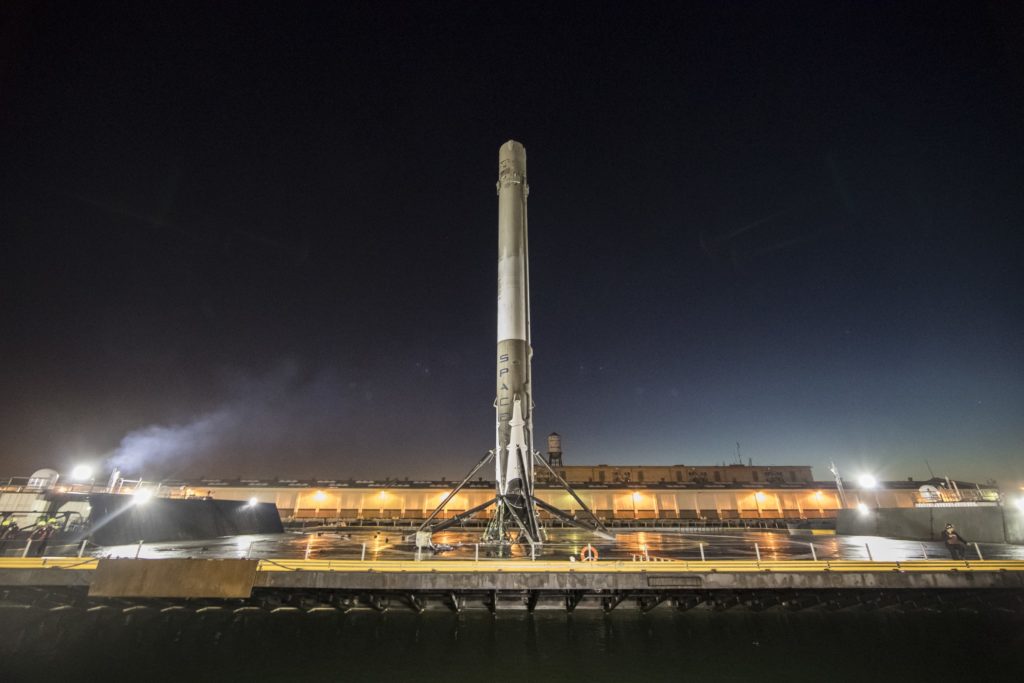
The decidedly scenic nighttime recovery of SpaceX’s previous Iridium-1 launch. (SpaceX)
Jumping over to the East Coast, Of Course I Still Love You is currently estimated to arrive in Port Canaveral sometime tomorrow, but that could certainly slip to June 30th depending upon port traffic. The previously reused stage it is carrying was noted to have landed very hard and had a discernible lean due to the crush core in its landing legs being fully utilized. As a result, a great deal of care is likely being take in ensuring the successful return of the stage to port. Aside from making recovery a bit harder for the crew, the lean is of little concern to the actual condition of the recovered stage. For example, the only other leaning first stage has now been converted into a side booster for the upcoming debut of Falcon Heavy, following its successful launch of the Thaicom-8 satellite in May of 2016.
- Falcon 9 1029’s lean is decidedly more extreme than the stage that launched Thaicom-8. (SpaceX)
- The aggressive Atlantic Ocean landing of Thaicom-8’s Falcon 9 first stage. (SpaceX)
All things considered, it has been and will continue to be quite a birthday week for Elon Musk. Three launches – one being a successful first stage reuse – and two recoveries in nine days are a staggering accomplishment for SpaceX and a resounding affirmation of Musk’s vision of routine and affordable access to space.
Nevertheless, SpaceX and Musk of course do not sleep, and LC-39A’s transporter erector is currently inside the pad’s integration facility for a static fire tomorrow before yet another launch this Sunday.

Elon Musk
Elon Musk and Tesla AI Director share insights after empty driver seat Robotaxi rides
The executives’ unoccupied tests hint at the rapid progress of Tesla’s unsupervised Robotaxi efforts.

Tesla CEO Elon Musk and AI Director Ashok Elluswamy celebrated Christmas Eve by sharing personal experiences with Robotaxi vehicles that had no safety monitor or occupant in the driver’s seat. Musk described the system’s “perfect driving” around Austin, while Elluswamy posted video from the back seat, calling it “an amazing experience.”
The executives’ unoccupied tests hint at the rapid progress of Tesla’s unsupervised Robotaxi efforts.
Elon and Ashok’s firsthand Robotaxi insights
Prior to Musk and the Tesla AI Director’s posts, sightings of unmanned Teslas navigating public roads were widely shared on social media. One such vehicle was spotted in Austin, Texas, which Elon Musk acknowleged by stating that “Testing is underway with no occupants in the car.”
Based on his Christmas Eve post, Musk seemed to have tested an unmanned Tesla himself. “A Tesla with no safety monitor in the car and me sitting in the passenger seat took me all around Austin on Sunday with perfect driving,” Musk wrote in his post.
Elluswamy responded with a 2-minute video showing himself in the rear of an unmanned Tesla. The video featured the vehicle’s empty front seats, as well as its smooth handling through real-world traffic. He captioned his video with the words, “It’s an amazing experience!”
Towards Unsupervised operations
During an xAI Hackathon earlier this month, Elon Musk mentioned that Tesla owed be removing Safety Monitors from its Robotaxis in Austin in just three weeks. “Unsupervised is pretty much solved at this point. So there will be Tesla Robotaxis operating in Austin with no one in them. Not even anyone in the passenger seat in about three weeks,” he said. Musk echoed similar estimates at the 2025 Annual Shareholder Meeting and the Q3 2025 earnings call.
Considering the insights that were posted Musk and Elluswamy, it does appear that Tesla is working hard towards operating its Robotaxis with no safety monitors. This is quite impressive considering that the service was launched just earlier this year.
Elon Musk
Starlink passes 9 million active customers just weeks after hitting 8 million
The milestone highlights the accelerating growth of Starlink, which has now been adding over 20,000 new users per day.

SpaceX’s Starlink satellite internet service has continued its rapid global expansion, surpassing 9 million active customers just weeks after crossing the 8 million mark.
The milestone highlights the accelerating growth of Starlink, which has now been adding over 20,000 new users per day.
9 million customers
In a post on X, SpaceX stated that Starlink now serves over 9 million active users across 155 countries, territories, and markets. The company reached 8 million customers in early November, meaning it added roughly 1 million subscribers in under seven weeks, or about 21,275 new users on average per day.
“Starlink is connecting more than 9M active customers with high-speed internet across 155 countries, territories, and many other markets,” Starlink wrote in a post on its official X account. SpaceX President Gwynne Shotwell also celebrated the milestone on X. “A huge thank you to all of our customers and congrats to the Starlink team for such an incredible product,” she wrote.
That growth rate reflects both rising demand for broadband in underserved regions and Starlink’s expanding satellite constellation, which now includes more than 9,000 low-Earth-orbit satellites designed to deliver high-speed, low-latency internet worldwide.
Starlink’s momentum
Starlink’s momentum has been building up. SpaceX reported 4.6 million Starlink customers in December 2024, followed by 7 million by August 2025, and 8 million customers in November. Independent data also suggests Starlink usage is rising sharply, with Cloudflare reporting that global web traffic from Starlink users more than doubled in 2025, as noted in an Insider report.
Starlink’s momentum is increasingly tied to SpaceX’s broader financial outlook. Elon Musk has said the satellite network is “by far” the company’s largest revenue driver, and reports suggest SpaceX may be positioning itself for an initial public offering as soon as next year, with valuations estimated as high as $1.5 trillion. Musk has also suggested in the past that Starlink could have its own IPO in the future.
News
NVIDIA Director of Robotics: Tesla FSD v14 is the first AI to pass the “Physical Turing Test”
After testing FSD v14, Fan stated that his experience with FSD felt magical at first, but it soon started to feel like a routine.

NVIDIA Director of Robotics Jim Fan has praised Tesla’s Full Self-Driving (Supervised) v14 as the first AI to pass what he described as a “Physical Turing Test.”
After testing FSD v14, Fan stated that his experience with FSD felt magical at first, but it soon started to feel like a routine. And just like smartphones today, removing it now would “actively hurt.”
Jim Fan’s hands-on FSD v14 impressions
Fan, a leading researcher in embodied AI who is currently solving Physical AI at NVIDIA and spearheading the company’s Project GR00T initiative, noted that he actually was late to the Tesla game. He was, however, one of the first to try out FSD v14.
“I was very late to own a Tesla but among the earliest to try out FSD v14. It’s perhaps the first time I experience an AI that passes the Physical Turing Test: after a long day at work, you press a button, lay back, and couldn’t tell if a neural net or a human drove you home,” Fan wrote in a post on X.
Fan added: “Despite knowing exactly how robot learning works, I still find it magical watching the steering wheel turn by itself. First it feels surreal, next it becomes routine. Then, like the smartphone, taking it away actively hurts. This is how humanity gets rewired and glued to god-like technologies.”
The Physical Turing Test
The original Turing Test was conceived by Alan Turing in 1950, and it was aimed at determining if a machine could exhibit behavior that is equivalent to or indistinguishable from a human. By focusing on text-based conversations, the original Turing Test set a high bar for natural language processing and machine learning.
This test has been passed by today’s large language models. However, the capability to converse in a humanlike manner is a completely different challenge from performing real-world problem-solving or physical interactions. Thus, Fan introduced the Physical Turing Test, which challenges AI systems to demonstrate intelligence through physical actions.
Based on Fan’s comments, Tesla has demonstrated these intelligent physical actions with FSD v14. Elon Musk agreed with the NVIDIA executive, stating in a post on X that with FSD v14, “you can sense the sentience maturing.” Musk also praised Tesla AI, calling it the best “real-world AI” today.
